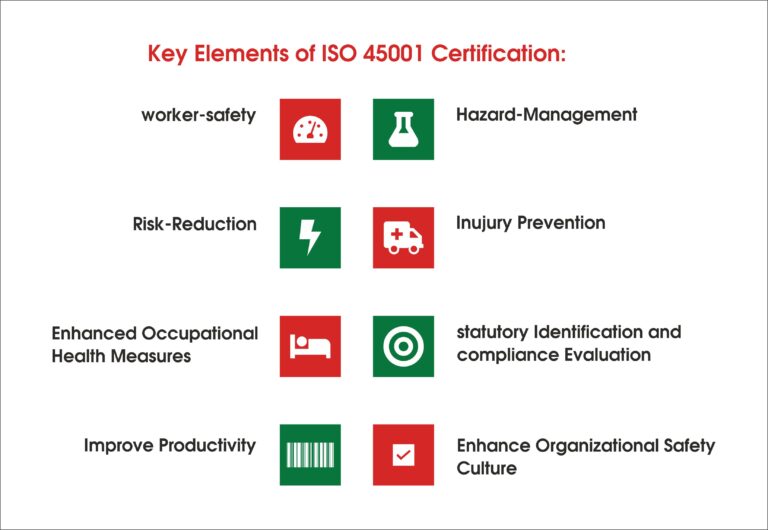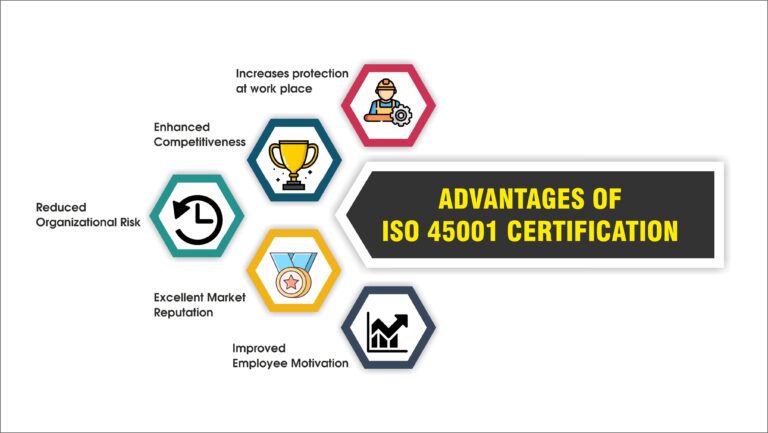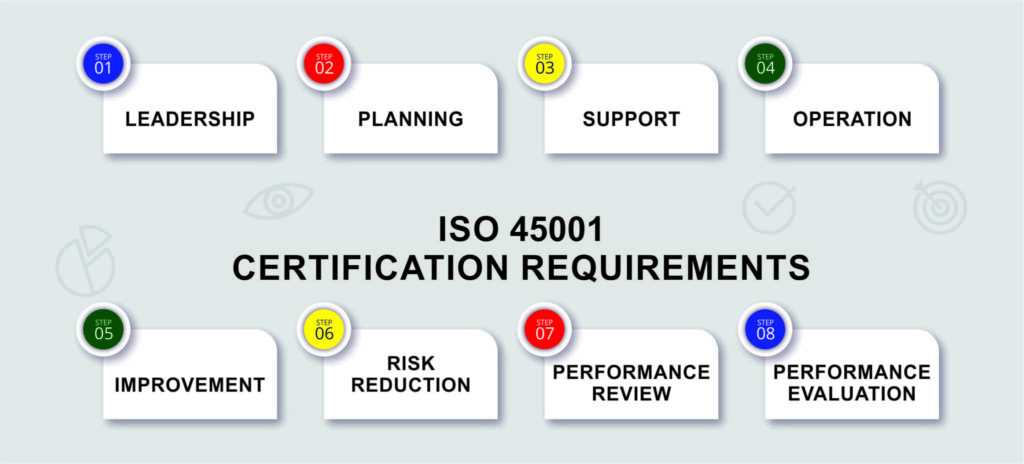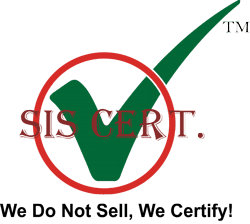ISO 45001 Certification
Home » ISO 45001 Certification
CONTACT WITH US
ISO 45001 Occupational Health and Safety Management (OHSMS) Certification
What is ISO 45001 Occupational Health and Safety Management System?
ISO 45001 is also known as Occupational Health and Safety Management System. It provides a framework for ensuring the safety and health of employees. ISO 45001 is an international standard on process improvement. It is a process-centred approach to quality management and applies throughout an enterprise, including the customer experience. It facilitates the organizations with a regulatory set of norms, shaping the organization into proactive than reactive. The ISO 45001 is a business localization tool that enables users to trace how the overall quality management of a manufacturing organization supports marketing efforts. It is a common quality standard for any organization assisting with the supply chain management system.
It addresses four dimensions. The four dimensions are as Process, Product, People and Organization. The ISO 45001 standard defines what an organization needs to know to start a quality management system. It encourages the use of generic principles that allow organizations to focus on getting their basic processes right to meet the needs of each customer. It talks about four focus areas. These four interrelated areas as People, Environment and Performance, Information and Communication and Leadership.
What is ISO 45001 Certification for Occupational Health and Safety Management System (OHSMS)?
ISO 45001:2018 Certification is a set of standards that helps in implementing the occupational health and safety management system (OHSMS) in an organization. the recent version of this standard was published in March 2018, and it aims at preventing any disease or hazard that are occupation-related. It has a common High-Level Structure (HLS) as that of the other standards such as ISO 9001:2015 and ISO 14001:2015 Certification, which makes the integration easier.
ISO 45001 is a revamped version of OHSAS 18001 standard which was also used for the purpose of OH&S assessments. Thus, any organization that is already certified with OHSAS 18001 can easily migrate to ISO 45001:2018. The window for migration was of three years from the day of it publish, but due to Covid-19 pandemic, there has been further extension of deadline. Although derived from OHSAS 18001, ISO 45001 differs from it in some ways.
ISO 45001:2018 Certification is an upgradation and replacement of earlier standard, OHSAS 18001 Certification
ISO 45001:2018 Certification is an upgradation and replacement of earlier standard, OHSAS 18001 Certification. The revamped version has simplified the integration of the occupational health and safety management system (OHSMS) with other management systems. This is because it shares the new common structure, Annex SL of ISO 9001:2015 and ISO 14001:2015 Certification.
You can find out more about this standard as well as the differences with respect to OHSAS 18001 Certification here. For the organizations that already have OHSAS 18001 Certification, the last date for migrating to ISO 45001:2018 Certification was 31st January.
Due to the Covid-19 pandemic, this date has been further extended. SIS Certifications will help you in migration audits, as well as in fresh applications to ISO 45001 certification.
What is the significance of obtaining ISO 45001 certification?
To showcase proof of your organization’s sincerity and commitment towards the well-being of the workforce as well as external clients, getting ISO 45001 certification is essential. This brings confidence among the customer, clients, employees as well as the community at large that your organization, apart from being profit-centric, also focuses on the health and safety of all the associated parties.
Evolution of ISO 45001 Compliance
The ISO 45001 is considered one of the most popular ISO 45000 standards for health and safety management. It has found its way into many organizations worldwide. The first edition of ISO 45001 was published in 1989. It was last revised in 2018. BSI formally withdrew OHSAS 18001 in September 2021 and replaced it with ISO 45001 and the current version of ISO 45001 is known as ISO 45001:2018.
Purpose of Applying for ISO 45001 Certification?
ISO 45001 adopts a risk-based approach and ensures an effective and continually improving management to meet customer requirements. It provides a framework for the safety and health of employees and identifies potential risks and opportunities.
It offers a proactive approach that helps to identify hazards and access risks and makes an organization safe and better. It allows an organization to fix the systems and improve any shortcomings.
Why ISO 45001 Certification is good for your organization?
The ISO 45001 certification is designed to prevent diseases, injuries or even death that are associated with the nature of work. Thus, it ensures a safe workplace.
Since ISO 45001 is global in nature, it goes beyond geographic, political or social borders. It aims at setting an international benchmark for management of occupational health and safety. Thus, it makes it simpler for those organizations that operate at a global scale.
Key Elements of ISO 45001 Certification

Why the world needs ISO 45001 for Workplace Safety : so as to Create Safe and Healthy Work Environment
The International Organizations for Standardization (ISO) has developed the ISO 45001 certification to enhance the productivity and effectiveness of workplaces for to following reasons:-
- Every 15 seconds, an organization faces work-related accidents and diseases resulting in the death of a worker.
- Globally around 152 work-related incidents and injuries are reported every 15 seconds.
- Over 2.3 million casualties and 300 million non-fatal accidents occur annually.
ISO 45001:2018 Certification helps organizations reduce workplace incidents and accidents. Moreover, it creates a productive and healthy work environment. Organizations without an ISO 45001 Certification will find it challenging to manage such incidents, thus resulting in decreased production and productivity.
ISO 45001 Certification (Occupational Health and Safety Management System) – if your employees are not safe then your organization is eager to liquidate, help your employees feel safe and connected with you with ISO 45001.
ISO 45001 is an international standard that specifies requirements for an Occupational Health and Safety (OH&S) Management System. It helps organizations improve their OH&S performance by providing a framework for the identification and control of workplace hazards and risks. The standard was developed by the International Organization for Standardization (ISO) and was first published in March 2018.
This standard is meant to help organizations improve their OH&S performance and provide a safer work environment for employees. It can be used by any organization, regardless of size or industry.
What is the importance of ISO 45001 Certification for Occupational Health and Safety Management System (OHSMS)?
An ISO 45001 is a occupational health and safety management system standard that provides guidance and information on designing, implementing and maintaining effective management at all levels. This ISO 45001 certification is one of the most important ISO certifications for your firm because it sets the health and safety standard for your business.
ISO 45001 can be critical for your organization in the following ways:-
- It describes the quality management system to ensure that the environment, customers, and employees are safe.
- It acts as a framework that allows companies to understand their key areas and build appropriate goals.
- ISO 45001 helps companies to know their customer using the best possible methods. It also helps them to find out the success factors, which will help them in achieving customer satisfaction in a better way.
- ISO 45001 is a management system that helps companies to improve their quality management system and comply with laws, regulations, internal policies and standards.
- It provides a framework of requirements and guidelines to help organizations develop standardized processes, procedures, and documentation to focus on customer satisfaction while increasing quality and productivity.
Goals of ISO 45001 Standards
Organizations adopt ISO 45001 certification with the goal of eliminating work-related risks and hazards. It lowers the risk of incidents, deaths, and diseases at workplaces by providing a resilient and structured framework. Furthermore, the ISO 45001 standard adopts a proactive approach to creating safe and healthy workplaces. Implementing ISO 45001 certification process protects your organization from any disruptions in operations and improves the organization’s overall performance.
The ISO 45001 certification supports the United Nation’s Sustainable Development Goals by formulating responsible and accountable corporate strategies. Moreover, it aims to safeguard the life and health of employees by identifying work-related hazards and risks.
Organizations must develop a health and safety management system that meets the requirements of the ISO 45001 standards. Additionally, it implements appropriate tools and controls to reduce workplace deaths, injuries, and diseases. The certification body then conducts the audit, and once your system gets certified, it is the responsibility of the organization to maintain compliance.
Read more – ISO 45001 प्रमाणन आपके व्यवसाय को कैसे बेहतर बना सकता है
What topics do ISO 45001 Certification cover?
ISO 45001:2015 certification has a High-Level Structure (HLS) that is composed of ten sections, out of which the first three are introductory in nature, whereas, the last seven gives specifications for implementing the Occupational Health and Safety Management System in an organization. Theses are:
Context of the organization
Leadership
Planning
Support
Operation
Performance evaluation
Improvement
For whom is 45001 Certification suitable?
The flexibility of this standard makes it suitable for wide range of organizations, irrespective of their size or sector. These include:
- Large organizations and enterprises
- Small and medium-sized enterprises
- Public and not-for-profit organizations
- Non-government organizations (NGOs) and charities
Benefits of ISO 45001 - Health & Safety Certification
Positions your business as an industry leader.
Makes the management responsible.
Helps you focus on your core business.
Deals with risk and opportunities.
Increases return on investment (ROI).
Ensures efficiency by ensuring consistency.
Ensures individual’s health and safety.
Helps you in obtaining insurance at lower rates.
Makes you trustworthy.

How ISO 45001 contributes to attaining the United Nation’s Sustainable Development Goals
Organizations adopt ISO 45001 certification with the goal of eliminating work-related risks and hazards. It lowers the risk of incidents, deaths, and diseases at workplaces by providing a resilient and structured framework. Furthermore, the ISO 45001 standard adopts a proactive approach to creating safe and healthy workplaces. Implementing ISO 45001 certification process protects your organization from any disruptions in operations and improves the organization’s overall performance.
The ISO 45001 certification supports the United Nation’s Sustainable Development Goals by formulating responsible and accountable corporate strategies. Moreover, it aims to safeguard the life and health of employees by identifying work-related hazards and risks.
Organizations must develop a health and safety management system that meets the requirements of the ISO 45001 standards. Additionally, it implements appropriate tools and controls to reduce workplace deaths, injuries, and diseases. The certification body then conducts the audit, and once your system gets certified, it is the responsibility of the organization to maintain compliance.
What are the Benefits of Implementing ISO 45001 within an Organisation
There are many benefits of ISO 45001 Certification, including improved safety performance, reduced accidents and injuries, and lower insurance costs. Certification also demonstrates a commitment to employee safety and can help your organization win new business.
In addition, ISO 45001 certification is voluntary, meaning that your organization can choose to certify without being required to do so by law or regulation. This allows you to tailor your safety management system to the specific needs of your organization.
Finally, ISO 45001 certification is internationally recognized, providing a valuable credential for your organization that can help you compete in the global marketplace.
Getting Certified to ISO 45001 Certification
Once you have developed your OHSMS through ISO 45001 Certification, getting yourself certified is pretty simple. The International Organization for Standardization does issue certificates, it just publishes the standards. The certification is performed by an external certification body. party. Here are the basic steps in getting certified to ISO 45001:
Develop and implement an ISO 45001 Certification management system.
Schedule an audit with SIS Certifications.
An auditor will review for compliance of your processes to the requirements of ISO 45001:2018.
Close the gaps, if any.
Once you conform to all the requirements, get yourself certified.
How much does ISO 45001 Certification Cost?
The Cost of ISO 45001 Certification Services varies from one organization to another organization. It depends on many factors as:- the size of your organization, The number of branches of your organization the number of employees in your company, and many others.
ISO 45001 certification cost also depends on the certification body you choose. It is crucial to select a reputed and good certification body. SIS Certifications is one of the leading ISO Certification bodies. SIS Certifications is an internationally accredited body by IOAS and IAS. We have a team of auditors and technical experts committed to helping you manage risks and access to the global market.
Requirements of ISO 45001 Certificate

The ISO 45001 Occupational Health and Safety Management System ( OH&SMS) Certification determines the critical requirements to implement an effective management system. These requirements are grouped into ten different sections (Section 1 to Section 10) and follow the Plan-Do-Check-Act (PDCA) approach.
ISO 45001 certification requirements checklist based on the PDCA cycle is as follows:-
– Section 1 to Section 6 is associated with the planning stage.
– (Section 1 to Section 3 is introductory).
– Section 7 and Section 8 are related to the Do stage.
– Section 9 is associated with the Check stage.
– Section 10 is in the Act stage.
Context to organization – The organization should determine all the internal and external issues related to the firm. It defines the scope of Occupational Health and Safety policy and strives to establish effective Occupational Health and Safety management.
Leadership and worker participation – The top-level management should implement an effective occupational health and safety policy. It is essential to communicate all the policies and visions within the management and win workers’ support to establish an effective management system.
Planning – It works on detecting and preventing approaches. It identifies all the potential risks and opportunities that might occur and formulates strategies to mitigate the risks and reap the opportunities.
Support – The organization should provide the resources, either human resources or raw materials, to establish an effective management system. It requires providing necessary training to the employees and ensures the competency of workers based on appropriate training, experience, and education.
Operation – It documents standards for the processes and implements controls based on the criteria. It establishes and implements policies to eliminate hazards and risks related to occupational health and safety.
Performance evaluation – ISO 45001 Compliance provides for monitoring, analyzing, and measuring processes to identify shortcomings in the business operations. It also evaluates the OH&S performance of the organization and determines areas that need improvement.
Improvement – It focuses on establishing and implementing necessary actions to achieve an effective Occupational health and safety management system. It aims to take corrective actions for continual improvement of the organization and promotes workers’ participation and safety.
PDCA Cycle
- Plan – to think that what do we need to achieve in our organization
- Do – to execute a planned action which will help us achieve the required objective
- Check – monitor against the standards) (policies, objectives, requirements)
- Action – finally implementing what has been rechecked.
ISO Certification Process
3 Steps to Certification
With the help of SIS Certifications, the certification process can take as little as 40 days to complete
Gap Analysis
- Assess your management system's compliance with the requirements of the applicable standard.
- Discuss what needs to be included in the project plan and agree on any remedial action.
- Identifying any non-conforming areas.
- Set the groundwork for a project plan.
Implementation
- ISO certification is an extensive procedure that necessitates knowledge and experience.
- SIS Certifications is not engaged in the implementation or preparation of documents to obtain ISO Certification.
- SIS Certifications does not participate in this implementation phase since it would jeopardize our integrity and impartiality as a certifying authority.
- Organizations need to dedicate the appropriate resources, time, and effort to implementing management systems and procedures.
Certification
- Application Form : Clients must fill out the basic data of the organization in the application form.
- Contract Review: Our quality team evaluates the client's requirements.
- Audit: Stages 1 and 2
- Decision Making : The DM team makes the decision to provide the certification.
- Stage One (documentation review) – At this stage, the auditors from the certification body verify that your documentation meets the requirements of ISO 45001.
- Stage Two (main audit) – In this stage, the realities of your processes are matched with your statements in the documentation for their compliance with the requirements of ISO 45001 standards clauses.
the certification process goes further. Click here to view the next steps to the ISO certification process
ISO 45001 Frequently Asked Questions (FAQs)
Answer: ISO 45001 is a globally recognized health and safety management standard. It is an international standard that promotes a safe and healthy working environment. The development of ISO 45001 is carried out by national and international standards committees that operate independently of government entities.
Answer: The ISO 45001 transition helps organizations adhere to the OHSAS standard required to shift to ISO 45001:2018. Despite being based on the achievements of the previous standard (BS OHSAS 18001), ISO 45001 supersedes it, becoming the sole and most recent version of the ISO 45001 standard.
Answer : The International Organization for Standardization (ISO) released the first version of the standard in October 2013. The ISO/PC 283 committee was part of the standard development committee and was established in 2013 specifically for this purpose. The development of ISO 45001 involved the active participation of over 70 countries. The preparatory and committee work continued until December 2015.
Answer : ISO 45001 is an internationally recognized standard for Occupational Health and Safety Management System. It offers a practical framework to enhance the safety and health of employees and other personnel. Importantly, ISO 45001 applies to companies of all sizes, types, and industries, ensuring its relevance across diverse organizational contexts.
Answer: ISO 45001 is a globally recognized international standard for occupational health and safety. It ensures the protection of employees and visitors from work-related accidents and illnesses. Achieving ISO 45001 certification helps organizations mitigate any potential factors that could cause significant harm to both employees and businesses.
Answer : The core focus of the ISO 45001 standard is proactive planning to prevent undesirable outcomes, such as non-compliance with regulations or the potential for employee injuries. Notably, the standard acknowledges the importance of identifying and embracing opportunities as a fundamental aspect of Occupational Health and Safety (OH&S) initiatives.
Answer: It is vital to manage and address all factors that could lead to illness, injury, and, in severe cases, fatality. ISO 45001 encompasses all these aspects and aims to mitigate any adverse impact on an individual’s physical, mental, and social well-being.
Answer: ISO 45001 offers a goldmine of benefits by establishing a safer and healthier work environment. Moreover, it identifies weak areas and eliminates appropriate measures to reduce accidents and incidents. It improves employee morale, reduces absenteeism, and increases confidence among stakeholders.
Answer: ISO 45001 replaces OHSAS 18001. It facilitates a smooth transition and provides a well-defined plan to streamline business operations. However, this plan commences with conducting a comprehensive gap analysis, which involves comparing your current practices to the requirements outlined in the ISO 45001:2018 standard.
Answer: External factors encompass cultural, social, political, regulatory, financial, economic, natural, and competitive aspects at international, national, regional, or local levels. Internal factors involve an organization’s activities, products, services, strategic direction, and capabilities concerning people, knowledge, processes, and systems.
Answer: The process of obtaining ISO 45001 Certification involves two stages: Stage 1 focuses on developing, implementing, and maintaining a suitable Occupational Health and Safety Management System (OHSMS) for your organization, while Stage 2 requires engaging the services of a Certification Assessment Body (CAB) to conduct the necessary evaluations and audits.
Answer: The integration and implementation of ISO 45001:2018 standards within the existing management system vary from organization to organization depending on the size, complexity, and existing safety practices. Small organizations might take a few months to implement; however, large organizations require a year or more.
Answer : ISO 45001 standards demonstrate an organization’s ability to identify work-related risks and hazards and eliminate them to reduce work-related incidents, injuries, diseases, and death. It aims to establish safe workplaces for employees, customers, suppliers, and stakeholders. An ISO 45001-certified organization maintains compliance with all laws, regulations, and standards to create safe and healthy workplaces for employees.
Answer: The ISO 45001 training program provides the necessary skills and expertise for an individual to understand Occupational Health and Safety Management requirements and conduct ISO 45001 audits to measure compliance.
Answer: ISO 45001 is an Occupational Health and Safety Management System (OHSMS) standard. It is a universally accepted standard for occupational health and safety and demonstrates an organization’s compliance with various laws, regulations, and standards related to occupational health and safety. It incorporates international best practices within the organization to improve their performance and prevent work-related injuries, accidents and deaths. It removes trade barriers and enhances the marketability and profitability of organizations.
Answer: ISO 45001 is a third-party certification that demonstrates that your organization is an externally verified organization for maintaining ISO 45001 requirements. It boosts the trust and confidence of customers, clients, employees, and stakeholders in your brand and enhances your reliability and credibility. It shows an organization’s ability to create safe and healthy workplaces and reduce work-related risks and hazards.
Answer: Implementing ISO 45001 certification is a complex process, but its duration varies from organization to organization, depending upon its size and the number of employees.
Answer: Yes, a human factor is one of the elements affecting occupational health and safety. The organization should therefore consider human factors within the scope of its occupational health and safety management system and use the ISO 45001 framework for addressing and managing work-related hazards and risks.
Looking for ISO Certification or Training Services?
Join one of the India’s leading ISO certification bodies for a straightforward and cost-effective route to ISO Certifications.
